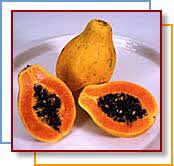Home | FOOD ARTICLES | Food Trivia | Today_in_Food_History | Food_History_Timeline | Recipes | Cooking_Tips | Food_Videos | Food_Quotes | Who’s_Who | Culinary_Schools_&_Tours | Food_Trivia_Quizzes | Food_Poems | Free_Magazines | Food_Festivals_and_Events
Food Articles, News & Features Section
FREE Magazines
and other Publications
Free Professional and Technical Research, White Papers, Case Studies, Magazines, and eBooks
PAPAYA
See Also: Papaya Trivia
Papaya Kitchen Tips
Tropical Fruit: The exact origination of papaya is unknown but it is believed to be native to southern Mexico and neighboring Central America. The papaya is a melon like fruit with yellow-orange flesh enclosed in a thin skin that varies in color from green to orange to rose. Papayas are a rich source of vitamin A and C. One half of a small papaya can provide 150% of the recommended dietary intake of Vitamin C. It is low in calories, fat free, cholesterol free, and a good source of potassium, folate, and fiber.
Today papaya can be found all year long with the peak season being early summer and fall. Most of the papayas imported come from Hawaii, but smaller quantities from Florida, California, Mexico, Puerto Rico, and Central and South American countries are becoming more available.
The papaya enzyme called papain, is used as a meat tenderizer. It breaks down tough meat fibers. Its use is nothing new. South American cooks have been using papaya to tenderize meat for ages. It is sold as a component in powdered meat tenderizer available in most supermarkets.
 Selection
Selection
Look for papayas that are partly or completely yellow in color, depending on variety, that give slightly to pressure, but are not soft at the stem-end. Avoid papayas that are bruised, shriveled, or have soft areas. Papayas that are hard and green are immature and will not ripen properly. Uncut papayas have no smell. Papayas that are cut should smell sweet, not bad or fermented.
Storage
Slightly green papayas will ripen quickly at room temperature, especially if placed in a paper bag. As the papaya ripens, it will turn from green to yellow. Place ripe papayas in a plastic bag and store in the refrigerator. Papayas will keep for up to a week, but it's best to use them within a day or two.
Varieties
There are two types of papayas, the Hawaiian and Mexican. The Hawaiian varieties also known as Solo papayas, are found most often in supermarkets. These fruits are pear shaped, weigh about a pound each, and have yellow skin when ripe. The flesh is bright orange or pinkish, depending on the variety. The Mexican varieties are not as common but can be found in Latino supermarkets. Mexican papayas are much larger then the Hawaiian types and can weigh up to 20 pounds and be more than 15 inches long. Although the flavor is less intense than the Hawaiian varieties, they are still delicious and enjoyable.
Make Papayas Part of Your 5 A Day Plan
* Use papayas to make a hot and spicy salsa.
* Blend papaya with milk, yogurt, or orange juice for a breakfast smoothie.
* Puree papaya to make a delicious salad dressing or base for ice cream or sorbet.
* Add papaya slices to honeydew, melon, and strawberries to make a colorful fruit cup or salad.
RELATED ARTICLES
Please feel free to link to any pages of FoodReference.com from your website.
For permission to use any of this content please E-mail: james@foodreference.com
All contents are copyright © 1990 - 2025 James T. Ehler and www.FoodReference.com unless otherwise noted. All rights reserved.
You may copy and use portions of this website for non-commercial, personal use only.
Any other use of these materials without prior written authorization is not very nice and violates the copyright.
Please take the time to request permission.
